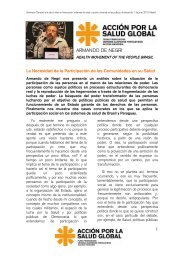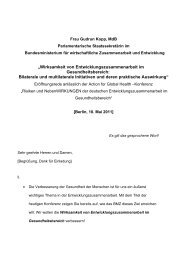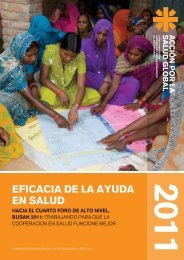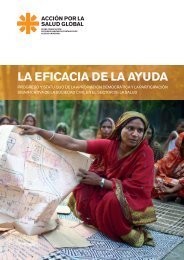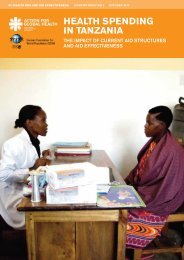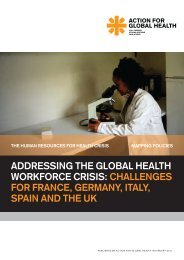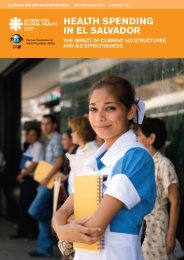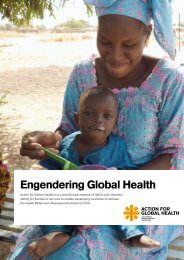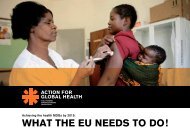Ethiopia Aid effectiveness in the health sector - Action for Global ...
Ethiopia Aid effectiveness in the health sector - Action for Global ...
Ethiopia Aid effectiveness in the health sector - Action for Global ...
You also want an ePaper? Increase the reach of your titles
YUMPU automatically turns print PDFs into web optimized ePapers that Google loves.
<strong>Ethiopia</strong> – <strong>Aid</strong> Effectiveness <strong>in</strong> <strong>the</strong> <strong>health</strong> <strong>sector</strong><br />
1. Country Overview<br />
<strong>Ethiopia</strong> is currently <strong>the</strong> second largest country <strong>in</strong> Africa by population and has<br />
one of <strong>the</strong> highest growth rates <strong>in</strong> <strong>the</strong> world at 3.21%. 1 Every year, <strong>the</strong><br />
population <strong>in</strong>creases by more than 2 million people. Over 84% of <strong>Ethiopia</strong>ns live<br />
<strong>in</strong> rural areas, 2 someth<strong>in</strong>g which, <strong>in</strong> a big country with little <strong>in</strong>frastructure and an<br />
extremely difficult topography, makes <strong>the</strong> task of deliver<strong>in</strong>g essential services<br />
very difficult and heavily dependent on <strong>in</strong>frastructure and <strong>in</strong>vestment.<br />
<strong>Ethiopia</strong> is among <strong>the</strong> poorest countries <strong>in</strong> <strong>the</strong> world. Despite robust economic<br />
growth over <strong>the</strong> last five years (over 11% annually), 3 <strong>the</strong> country still features<br />
169th out of 179 countries on <strong>the</strong> Human Development Index (HDI) rank<strong>in</strong>g. 4 The<br />
share of population liv<strong>in</strong>g below <strong>the</strong> national poverty l<strong>in</strong>e has decreased over<br />
<strong>the</strong> last few years, but still stands at 35%. At <strong>the</strong> same time, Gross Domestic<br />
Product (GDP) per capita <strong>in</strong> 2007 was US$780, or just over US$2 a day, which<br />
means a significant share of <strong>the</strong> population still lives below <strong>the</strong> World Bank’s<br />
moderate poverty l<strong>in</strong>e (<strong>the</strong> latest figure available is 78%). 5<br />
In <strong>the</strong> last few years, <strong>Ethiopia</strong> has ga<strong>in</strong>ed significance as an aid-recipient<br />
country. In 2001, <strong>Ethiopia</strong> received US$1 billion, two-thirds of which was<br />
provided by multilateral agencies and with a strong emergency component. In<br />
2007, <strong>the</strong> figure had risen to US$2.4 billion and slightly over half was provided by<br />
Organisation <strong>for</strong> Economic Cooperation and Development-Development<br />
Assistance Committee (OECD-DAC) donors. 6<br />
However, at present, <strong>the</strong> biggest Development Partners (DPs), both <strong>in</strong> general<br />
terms and <strong>in</strong> <strong>the</strong> <strong>health</strong> <strong>sector</strong>, are PEPFAR and <strong>the</strong> <strong>Global</strong> Fund to Fight AIDS,<br />
Tuberculosis and Malaria (see page 9). While <strong>the</strong> arrival of <strong>the</strong>se two donors has<br />
boosted resources <strong>in</strong> <strong>the</strong> <strong>health</strong> <strong>sector</strong>, it has also unbalanced <strong>the</strong> distribution<br />
of funds. Accord<strong>in</strong>gly, one of <strong>the</strong> ma<strong>in</strong> challenges <strong>for</strong> AE <strong>in</strong> <strong>Ethiopia</strong> is to<br />
<strong>in</strong>crease <strong>the</strong> harmonisation of vertical donors.<br />
Progress <strong>in</strong> <strong>the</strong> <strong>health</strong> <strong>sector</strong><br />
<strong>Ethiopia</strong> is also mak<strong>in</strong>g progress <strong>in</strong> <strong>the</strong> <strong>health</strong> <strong>sector</strong>. Maternal mortality rates<br />
have decreased from 871 deaths per 100,000 births <strong>in</strong> <strong>the</strong> 1990s to 673 per<br />
100,000 <strong>in</strong> 2005/2006. Similarly, <strong>the</strong> national under-five mortality rates also went<br />
down from 180 <strong>in</strong> 1992/1993 to 123 <strong>in</strong> 2004/2005. 7 In spite of <strong>the</strong> improvements,<br />
<strong>Ethiopia</strong> still has a long way to go. Both maternal and under-five mortality rates<br />
will have to decrease by half <strong>in</strong> order to meet MDGs 4 and 5 by 2015.<br />
We have seen that most people <strong>in</strong> <strong>Ethiopia</strong> live <strong>in</strong> rural areas. As a<br />
consequence, one of <strong>the</strong> ma<strong>in</strong> challenges <strong>for</strong> aid and <strong>the</strong> <strong>health</strong> <strong>sector</strong> <strong>in</strong><br />
<strong>Ethiopia</strong> is br<strong>in</strong>g<strong>in</strong>g <strong>health</strong> services to <strong>the</strong> population. This requires long-term<br />
programmes, susta<strong>in</strong>ed aid and good coord<strong>in</strong>ation among DPs, <strong>the</strong><br />
Governments and Non-Governmental Organisations (NGOs) work<strong>in</strong>g <strong>in</strong> <strong>the</strong><br />
8



